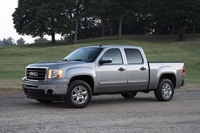GM Introduces More Hybrid Models; Hybrid Cadillac Escalade and GMC/Chevy Pickups Join Mix
By Rex Roy
Senior Editor
EV-Motoring.Com
There's a lot going on with hybrids these days. In January at the Detroit Auto show, Toyota announced their new third-generation Prius, and Honda re-introduced their hybrid, the 2010 Insight. But for a lot of drivers, these four-cylinder sedans just won't cut it.
 |
Now normally, if one mentions the model names Escalade or Sierra or Silverado … people automatically think "gas hog." But these full-size trucks deliver better city mileage than a sub-compact Scion tC coupe with a four-cylinder engine.
These three new GMs all use the same hybrid powertrain that has come from years of development that first bore fruit in 2008 with the Chevrolet Tahoe and GMC Yukon hybrid SUVs. These were the first production vehicles to feature what GM calls an electrically-variable transmission (EVT). Within a case that looks like a traditional automatic gearbox, GM (along with partners Mercedes-Benz, BMW, and Chrysler) managed to package two motor/generators and four fixed gear ratios.
When acting as motors, the EVT helps propel the these hybrids. As the SUV coasts or slows, the EVT goes into generator mode, transforming kinetic energy into electricity via regenerative braking. Countless hours of seat time went toward blending the EVT's regen braking with the physical braking systems, and the transitions between the two are indistinguishable. The recaptured energy goes from the EVT for chemical storage in a 300-pound, 300-Volt nickel-metal hydride battery pack that resides under the second row seats.
 |
A control unit manages all of the above elements using software that is much improved over the initial batch of GMC and Chevrolet SUVs. The result is that the new 2009 hybrids run strongly and smoothly. About all that's lost compared to the non-hybrid, and this is particular to the Escalade, is the intoxicating exhaust note of the 6.2-liter that comes standard in the Cadillac.
The sensation of driving the hybrids is a bit odd if one expects a traditional experience. In easy-going driving, the engine RPM and exhaust note don't correspond linearly to acceleration. The EVT works like a continuously variable transmission, so the 6.0-liter revs to a particular RPM and hangs there while the vehicle's speed seems to play catch-up.
The most curious sensation is when these trucks accelerate on battery power; it's like gliding. The engine's auto-stop feature also catches drivers off guard at first. While the engine shut-down is smooth (as is the re-start), a first reaction can be that the SUV stalled. Of course, it didn't. Running on battery power, the steering, climate control, and other vital functions remain completely operational in the Auto Stop mode.
Unlike the Toyota or Honda systems that engineers call single-mode hybrids, the GM system is a two-mode. Those single mode hybrid systems focus on delivering better city mileage, but they don't help much at highway speeds. GM's dual mode system improves city and highway mileage, plus it enables great towing capabilities. The two-wheel drive pickups can pull over three tons.
Compared to a regular Sierra, Silverado or Escalade, city mileage goes up 45%. Highway mileage goes up too, but not as much, just about 10% over one of the pickups with a 5.3-liter V-8.
As for performance other than mileage, the trucks are quick. They go from zero-to-60 in about 8 seconds, proving that you don't have to drive something slow or small to get good mileage. The two-wheel-drive versions of the pickups get 21 miles per gallon in the city and 22 mpg on the highway … again, that's better city mileage than a VW Jetta with a 2.5-liter four cylinder and an automatic.
Exterior differences between non-hybrid and hybrid versions of these trucks are minimal. The Escalade gets some badging and that's about it. The most noticeable differences regarding the pickups are the standard box tonneau covers that reduce aerodynamic drag by about 5-percent.
Moving up to one of these hybrids won't cost you a fortune. If you equalize the equipment on the hybrids with their non-hybrid counterparts, the cost is under four grand. As a matter of fact, regarding the Escalade and its $75,000 price tag, the real question potential drivers should ask is not "If I'm going to drive an Escalade, why should it be a Hybrid?" but "If I'm going to drive an Escalade, why would it not be the Hybrid?"
So to wrap this up, the hybrid Escalade, Sierra and Silverado can do most everything that the non-hybrid versions do, but they do it more efficiently. But more importantly, these trucks are proof that Detroit knows how to build amazingly sophisticated and efficient vehicles that people want … despite what bureaucrats in Washington think.
Rex Roy can be contacted through his web site: www.RexRoy.net



